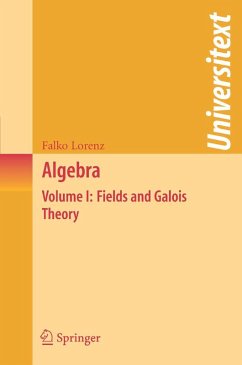The present textbook is a lively, problem-oriented and carefully written introduction to classical modern algebra. The author leads the reader through interesting subject matter, while assuming only the background provided by a first course in linear algebra. The first volume focuses on field extensions. Galois theory and its applications are treated more thoroughly than in most texts. It also covers basic applications to number theory, ring extensions and algebraic geometry. The main focus of the second volume is on additional structure of fields and related topics. Much material not usually covered in textbooks appears here, including real fields and quadratic forms, diophantine dimensions of a field, the calculus of Witt vectors, the Schur group of a field, and local class field theory.
Both volumes contain numerous exercises and can be used as a textbook for advanced undergraduate students. From Reviews of the German version: This is a charming textbook, introducing the reader to the classical parts of algebra. The exposition is admirably clear and lucidly written with only minimal prerequisites from linear algebra. The new concepts are, at least in the first part of the book, defined in the framework of the development of carefully selected problems. - Stefan Porubsky, Mathematical Reviews
Both volumes contain numerous exercises and can be used as a textbook for advanced undergraduate students. From Reviews of the German version: This is a charming textbook, introducing the reader to the classical parts of algebra. The exposition is admirably clear and lucidly written with only minimal prerequisites from linear algebra. The new concepts are, at least in the first part of the book, defined in the framework of the development of carefully selected problems. - Stefan Porubsky, Mathematical Reviews
Dieser Download kann aus rechtlichen Gründen nur mit Rechnungsadresse in A, B, BG, CY, CZ, D, DK, EW, E, FIN, F, GR, HR, H, IRL, I, LT, L, LR, M, NL, PL, P, R, S, SLO, SK ausgeliefert werden.
From the reviews:
"This is the faithful English translation of the German textbook 'Einführung in die Algebra: Teil I' by F. Lorenz ... . this introduction to classical abstract algebra quickly became one of the most popular texts ... . this outstanding textbook has been brought about by Springer Verlag, with some further improvements and in modern printing. ... the author offers quite a number of interesting methodological approaches, extra topics, and arithmetical applications. ... The present English edition is enhanced by a carefully compiled index of notation." (Werner Kleinert, Zentralblatt MATH, Vol. 1087, 2006)
"This textbook is a translation of the 1987 German edition. It is an introduction into the classical parts of algebra with a focus on fields and Galois theory. The clear and well written exposition requires only some basics from linear algebra. ... The book ends with an appendix containing exercises and notes on the previous parts of the book. It also includes brief historical comments. It can be highly recommended." (A. Winterhof, Internationale Mathematische Nachrichten, Issue 206, 2007)
"Algebra I: Fields and Galois Theory is ... a complete algebra course, including both undergraduate and graduate topics. ... uses Galois theory as a guiding line that leads the reader to excursions into arithmetic groups, rings, and of course fields. ... the choice of topics and their organization are excellent and provide a unifying view of most of algebra. In all, Lorenz's book is a wonderful reference for both teachers and researches, and can be used with much profit for independent study by hard-working students." (Luiz Hendrique de Figueiredo, MathDL, July, 2008)
"This is the faithful English translation of the German textbook 'Einführung in die Algebra: Teil I' by F. Lorenz ... . this introduction to classical abstract algebra quickly became one of the most popular texts ... . this outstanding textbook has been brought about by Springer Verlag, with some further improvements and in modern printing. ... the author offers quite a number of interesting methodological approaches, extra topics, and arithmetical applications. ... The present English edition is enhanced by a carefully compiled index of notation." (Werner Kleinert, Zentralblatt MATH, Vol. 1087, 2006)
"This textbook is a translation of the 1987 German edition. It is an introduction into the classical parts of algebra with a focus on fields and Galois theory. The clear and well written exposition requires only some basics from linear algebra. ... The book ends with an appendix containing exercises and notes on the previous parts of the book. It also includes brief historical comments. It can be highly recommended." (A. Winterhof, Internationale Mathematische Nachrichten, Issue 206, 2007)
"Algebra I: Fields and Galois Theory is ... a complete algebra course, including both undergraduate and graduate topics. ... uses Galois theory as a guiding line that leads the reader to excursions into arithmetic groups, rings, and of course fields. ... the choice of topics and their organization are excellent and provide a unifying view of most of algebra. In all, Lorenz's book is a wonderful reference for both teachers and researches, and can be used with much profit for independent study by hard-working students." (Luiz Hendrique de Figueiredo, MathDL, July, 2008)

